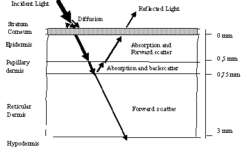Skin spectral properties

Understanding how light interacts with skin can assist in designing physics-based dermatological image processing. The key is to understand how light interacts with skin tissue. The skin consists of different layers with different spectral properties. When the incident light is applied to the skin layer, it is absorbed, and another part is scattered. The main layers of skin are as follows: Stratum cornea practically doesn’t absorb light but diffuses it; Epidermis consists of cells producing the pigment melanin. Melanin strongly absorbs light wavelengths towards the ultraviolet part; Dermis is next to the skin layer, consisting of collagen fibers. It can be split into two sublayers: The papillary dermis and the dermis itself. The papillary dermis consists of a high density of collagen fibbers who are strong scatterers of light. The primary requirement for the model is that light has to be scattered. Stratum cornea is supposed a scattering filter. Skin can be characterized as follows:





